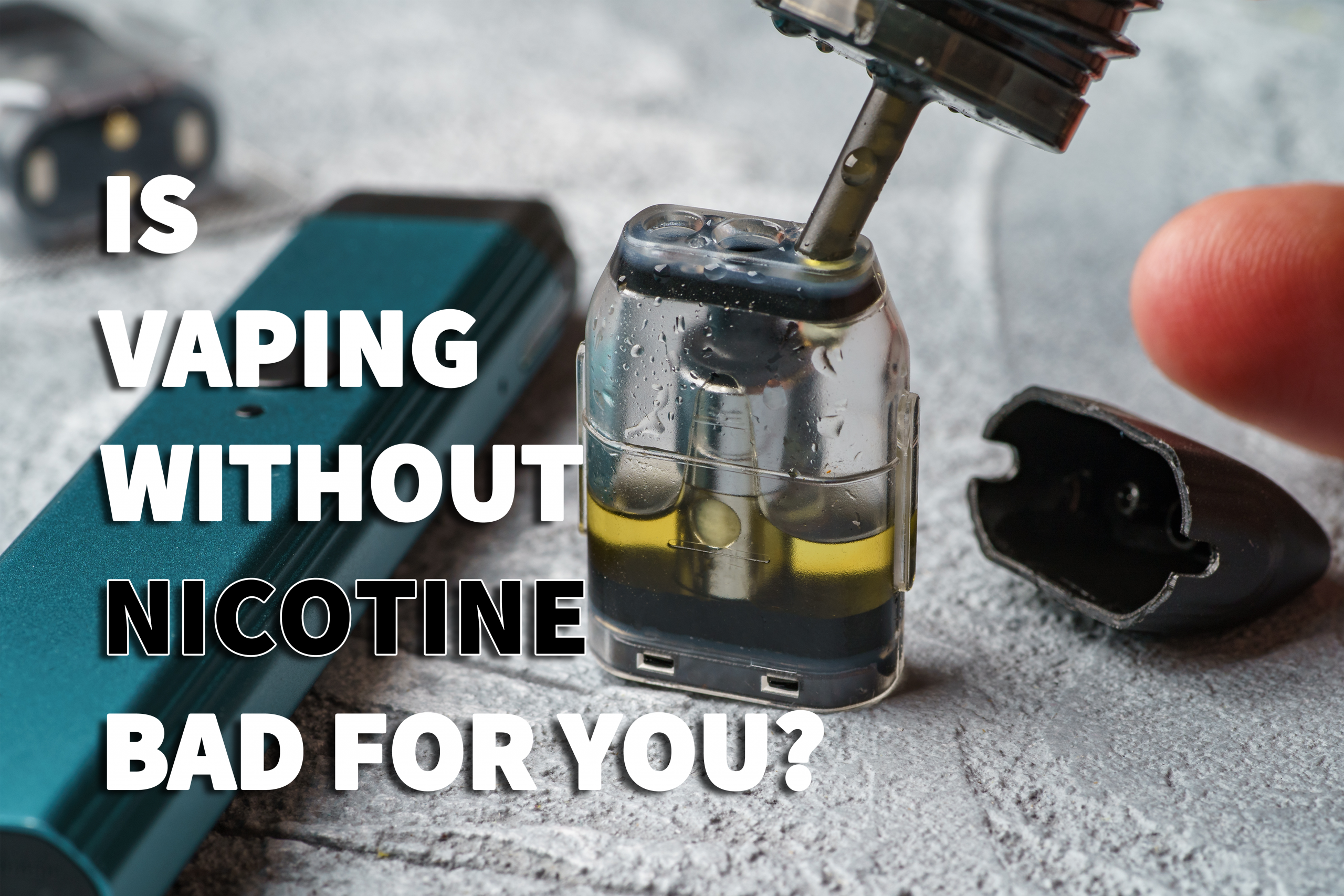Fluids that lack nicotine might appear less hazardous than those that contain it, but they can still produce adverse effects. Your personal risk varies based on the base liquids, flavoring agents, and other additives in the product.
There’s still much we don’t fully understand about vaping and the use of e-cigarettes. Investigations into both short- and long-term consequences are ongoing.
Still, evidence indicates vaping can cause side effects whether or not the e-liquid contains nicotine. Below is a summary of what is currently known about the adverse effects linked to different vaping fluids.

What side effects can nicotine-free fluids cause?
Irritation
When vapors are heated, ingredients in e-liquids can irritate the mouth and airways.
One study found that a single puff from a nicotine-free shisha pen released enough propylene glycol and glycerol — two common carrier liquids — to provoke irritation.
On heating, these compounds may also transform into substances that have the potential to be carcinogenic.
Inflammation
Vaping without nicotine appears to prompt immune system activity. A 2018 in vitro study reported that exposure can trigger an inflammatory response in immune cells.
Such inflammation is often most noticeable in the lungs or throat. Heavy vaping may provoke inflammation that affects the body more broadly.
Another 2018 in vitro study concluded that exposure to e-juice flavoring compounds can activate an inflammatory reaction in certain white blood cells, potentially altering how they function within your immune system.
Toxicity
Nicotine-free e-liquids may also be cytotoxic.
The same 2018 in vitro investigation discovered that exposure to e-cigarette vapor caused cell death even when nicotine was absent. The cells affected reside in the lungs and are responsible for protecting the body from toxins, pathogens, and airborne allergens.
Another study found that flavoring additives in e-cigarettes can damage vascular endothelial cells in the heart, which are important for long-term cardiovascular health.
Loss of these cells may contribute to vascular conditions such as hypertension, diabetes-related complications, and heart disease.
How does this compare with vaping fluids that contain nicotine?
There is substantial literature documenting the detrimental effects of nicotine, though much of it focuses on nicotine exposure from combustible tobacco.
For instance, nicotine use is linked to elevated risks of respiratory, cardiovascular, and gastrointestinal conditions. It’s also tied to immune suppression and reduced reproductive health.
Nicotine has carcinogenic properties and is addictive.
Although data are limited, some studies have compared nicotine-free e-cigarettes with those containing nicotine.
A small study of 20 participants compared the 24-hour effects of a nicotine-free e-cigarette among current cigarette smokers and people who had previously abstained from cigarettes or vaping.
One study reported that individuals who used nicotine-containing e-cigarettes experienced stronger dependence compared with those using nicotine-free devices.
Researchers observed no immediate change in lung function among participants who had been abstinent, while there was a slight negative effect on lung function in the group who smoked cigarettes.
Additionally, a 2018 study found that vaping liquids with nicotine produced a notable rise in blood pressure that persisted for about 45 minutes after vaping.
How do vaping effects compare with smoking cigarettes?
Reports indicate that cigarette smoking has broad detrimental impacts on health, including a raised risk of heart disease, stroke, and various cancers.
Smoking cigarettes remains the leading cause of preventable death in the United States.
Vaping nicotine-free fluids may carry fewer risks than cigarette smoking. However, both nicotine-free and nicotine-containing e-cigarettes pose health hazards.
Some individuals use vaping as a method to quit smoking. If you’re considering vaping as a cessation tool, it’s useful to be aware of potential harms and side effects — for more on risks associated with other quitting aids and supplements, see resources on detox tea side effects and fish oil side effects.
If you do not already smoke cigarettes, beginning to vape could actually increase your overall risk of harm rather than reduce it.
Do flavors influence the risks?
Certain e-liquid flavors are linked to harmful effects. In one study, researchers assessed 51 vape juice flavors for three potentially dangerous chemicals:
- diacetyl
- acetylpropionyl (2,3-pentanedione)
- acetoin
They detected one or more of these chemicals in 92 percent of the flavors tested. Moreover, 39 of the 51 flavors contained diacetyl concentrations above laboratory safety limits.
Diacetyl is commonly used in buttery or creamy flavorings and is associated with severe respiratory diseases when inhaled.
A 2018 study identified cinnamaldehyde (cinnamon flavor) as producing the most pronounced toxic effects on white blood cells.
O-vanillin (vanilla) and pentanedione (honey) also showed significant cellular toxicity.
Are there ingredients to avoid?
The Food and Drug Administration (FDA) regulates vaping devices and e-liquids, including those without nicotine.
Manufacturers are required to display a warning label on products that contain nicotine.
Other potentially hazardous flavoring chemicals found in e-liquids include:
- acrolein
- acrylamide
- acrylonitrile
- benzaldehyde
- citral
- crotonaldehyde
- ethylvanillin
- eucalyptol
- formaldehyde
- propylene oxide
- pulegone
- vanillin
Because manufacturers aren’t obligated to disclose a full list of e-liquid ingredients, it can be difficult to know which products to avoid.
You may find it prudent to steer clear of flavors commonly linked to respiratory irritants, such as:
- almond
- bread
- burnt
- berry
- camphor
- caramel
- chocolate
- cinnamon
- clove
- coffee
- cotton candy
- creamy
- fruity
- herbal
- jam
- nutty
- pineapple
- powdery
- red hot
- spicy
- sweet
- thyme
- tomato
- tropical
- vanilla
- woody
What are the effects of vaping cannabis?
Cannabis vaporizers do not contain nicotine but can still produce side effects, mainly due to tetrahydrocannabinol (THC), the psychoactive compound in cannabis.
The high from vaping cannabis may be stronger than that from traditional smoking. Other possible side effects include:
- memory problems
- reduced coordination
- difficulty solving problems
- changes in sensation and mood
- nausea
- vomiting
- increased heart rate
Vaping flavored cannabis oil can also lead to effects similar to those seen with nicotine-free e-cigarettes, depending on the base liquid and flavorings used.
What are the effects of vaping CBD?
CBD vaporizers don’t contain nicotine but can still result in side effects.
CBD, or cannabidiol, is one of the active compounds in cannabis. Unlike THC, CBD is non-psychoactive and does not produce a “high.”
Although research on vaping CBD is limited, common mild side effects of CBD use can include:
- irritability
- fatigue
- nausea
- diarrhea
Vaping flavored CBD oil may also cause side effects similar to those from nicotine-free e-cigarettes, depending on the base and flavoring ingredients.
Is Juuling different from vaping?
Juuling is essentially vaping; it refers to using a specific e-cigarette device that resembles a USB drive and is particularly popular among younger users.
Most Juul products contain nicotine, so the side effects discussed in this article related to nicotine apply to Juuling as well.
When should you see a healthcare professional?
See a doctor or other healthcare provider if you experience any of the following:
- persistent dry mouth
- loss of taste
- chronic coughing
- persistent sore throat
- bleeding or swollen gums
- mouth ulcers or sores that won’t heal
- toothache or oral pain
- receding gums
A clinician can evaluate your symptoms and determine whether vaping or an underlying condition is responsible.
Consider consulting a healthcare professional if you’re trying to cut down on smoking or vaping. They can guide you on reducing nicotine intake and ultimately quitting.


















Leave a Reply
You must be logged in to post a comment.